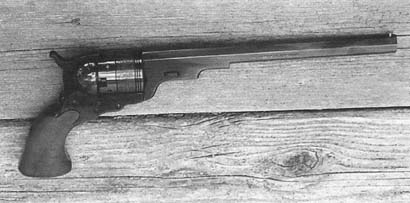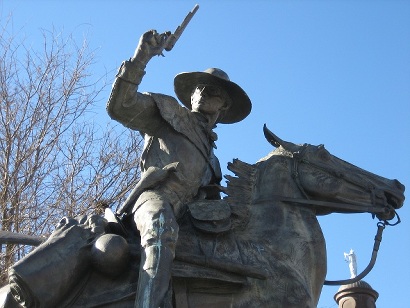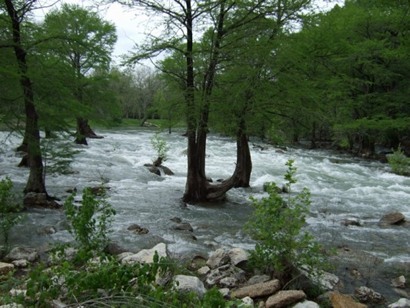|
Books by
Jeffery Robenalt
|
|
The
Battle of Walker's Creek was more of a minor skirmish than
a battle, but thanks to Sam Colt the outcome of the fight had pivotal
consequences in the long-running struggle between the Comanches and
the Texas Rangers. Given enough men, the Rangers could always dismount
and keep the Comanches at bay by firing in accurate, well-coordinated
volleys; some men firing while others reloaded. However, prior to
Walker's Creek, the Texans were at a distinct disadvantage
when it came to fighting on horseback.
A Comanche warrior on horseback could shoot five or six arrows from
his powerful short bow in the time it took a Ranger to dismount and
reload his rifle, and reloading a rifle while mounted was an even
slower and more cumbersome process. Moreover, the accuracy of the
bow and arrow in the hands of a mounted warrior was unquestioned,
while a Ranger firing his percussion rifle or pistol from horseback
was unlikely to hit anything. Darting in and out and slipping off
to the sides of their ponies, the Comanches would tempt the Rangers
into firing, then charge in for the kill.
During the Battle of Walker's Creek the Comanches attempted
to use their traditional style of mounted warfare, but this time thanks
to Sam Colt, each of the Rangers was armed with two rapid firing Paterson
revolvers. One Comanche who took part in the fight complained that
the Rangers "had a shot for every finger on the hand." |
|
|
Samuel
Colt
19th Century Engraving
wikipedia |
 |
The basic idea
of a revolving cylinder had been around for a long time. However,
it took a combination of Samuel Colt's genius and the emerging technology
of percussion caps to bring to life the concept of the first multiple-shot
revolver using a percussion cap to ignite a charge of powder that
in turn fired a round lead ball from the cylinder. Colt obtained a
patent for a repeating firearm in 1836, and began manufacturing the
Colt Paterson model revolver in 1837, in his Paterson, New Jersey
workshop.
Sam Colt produced several models of the Paterson, but model No. 5
was a five-shot .36 caliber percussion revolver with a nine inch barrel
and a folding trigger that only emerged when the hammer was cocked;
a feature common to all Paterson Colts. The revolver was a bit fragile
and the barrel had to be removed to switch cylinders, but the weapon
came with an extra cylinder or two, giving the user from ten to fifteen
shots before reloading was necessary. Colt's model No. 5 was referred
to as the "Texas" Paterson because of its use by the Texas
Rangers at Walker's Creek. How the Rangers got their hands
on the weapon is a story unto itself.
After the United States Army rejected the Paterson as being too impractical
— after all, who needed a sidearm that could fire five times
without reloading — Sam Colt turned to the new Republic of Texas.
In 1838, he sent a pair of the revolvers to President Sam
Houston, but the Texas Army rejected the weapon, thinking the
barrel would get too hot to handle, and that "the whole formation
seems to be too complicated for use in the field." Then a Washington
hotel owner whose son was serving in the Texas Navy wrote to the Secretary
of the Navy, praising the merits of Colt's revolver, and in 1839,
the Secretary ordered 160 of the new weapons. |
 |
The story turned
full circle when a January 16, Act of the Texas Congress authorized
Captain Jack Hays to raise a new Ranger company of forty privates
that was to operate from Bexar County to Refugio County and points
west. While meeting with President Houston to discuss his assignment,
Hays was informed the soon to be decommissioned Texas Navy had received
a shipment of the new Colt five-shooters, and that he could place
an order with the Secretary of War to equip his new company with the
revolvers. After personally securing the weapons from a Galveston
warehouse, Hays returned to San
Antonio and issued each of his new Rangers two Patersons.
The remainder of the winter of 1844 passed quietly, but after an uneventful
spring, word reached San
Antonio during the first week in June that a good sized Comanche
war party under the leadership of a war chief named Yellow Wolf was
raiding the settlements in the northern and western reaches of Bexar
County. In the first week of June 1844, Hays rode out of San
Antonio at the head of fourteen Rangers, all of them eager to
put their new Colts to the test. |
 |
|
The Rangers
thoroughly scoured the hills as far as the Pedernales River without
discovering any Comanche sign and reluctantly turned back, following
the Pinta Trail to the ford on the Guadalupe
River in the area of present day Kendall County. There they
set up camp near Walker's Creek. One of the Rangers, Noah
Cherry, spotted a bee tree, and he was half way up to seize his
prize when he called out, "Jerusalem, captain, yonder comes a
thousand Indians!"
Private Cherry scrambled back down the trunk of the bee tree, quickly
joining the other Rangers as they saddled up and mounted. The war
party, numbering between seventy and eighty warriors, withdrew to
some wooded terrain from which they apparently hoped to initiate
the ambush. Hays got the Rangers on line and advanced to within
a few hundred yards of the woods when fifteen or twenty warriors
rode out into the clear and began to badger them for a fight. The
rest of the war party remained hidden in the woods.
Hays had too much experience dealing with Comanches to fall into
such an obvious trap, and he waited patiently until the entire war
party emerged from the woods and formed a line of battle. A dry
ravine ran to the rear of the Comanche line, and beyond the ravine
rose a high, timber and brush covered hill strewn with rocks. Hays
gave the signal for his Rangers to advance at the trot, and the
Comanches fell back through the ravine and took cover on the hill.
From behind the rocks and trees, the warriors taunted the Rangers
in Spanish, hoping to lure them into making a frontal assault on
the formidable defensive position. However, instead of attacking,
Captain Hays cleverly used the cover of the dry ravine to move his
Rangers around the hill and come up behind the Comanches. After
quickly forming his men into a wedge formation, Hays led the attack
on the rear of the Indian line.
Ben McCulloch, a veteran Ranger and Hays's second in command, later
wrote that the fight for the top of the hill was hand-to-hand, and
"they took it rough and tumble." Fighting fiercely even though
heavily outnumbered, the Rangers drove off two counterattacks on
their flanks with the firepower of the Colt Patersons before the
Comanches finally fled the field.
Captain Jack
Hays led the pursuit for three miles, making sure his Rangers kept
the warriors under heavy fire with their revolvers. "Crowd them!
Powder-burn them!" were Hays's shouted orders.
During the running, three-mile, hour-long Comanche retreat, Yellow
Wolf rallied his warriors for three separate counterattacks with
the Rangers fighting in relays — one group quickly switching
the cylinders of their Colts while the other engaged the Comanches.
Just as Yellow Wolf was haranguing his warriors into making one
more attack, Ranger Ad Gillespie shot him in the head at thirty
yards. Now thoroughly demoralized, Comanches fled the field.
|
|
|
Captain
Sam Walker
wikipedia |
|
In the intense
struggle, Comanche casualties were estimated at from twenty to more
than fifty wounded or killed, including Yellow Wolf. One Ranger
was killed and four were seriously wounded. Among the latter was
Sam Walker, his body pierced by the thrust of a Comanche war lance.
Although not expected to live, Walker survived to become a national
hero during the Mexican American War and the co-designer along with
Sam Colt, of the famous "Walker" Colt revolver.
The fight at Walker's Creek, also known as the battle of
Pinta Trail Crossing, the battle of Asta's Creek, or the battle
of Sisters Creek, was characterized by the Houston Morning Star
as "unparalleled in this country for the gallantry displayed
on both sides, its close and deadly struggle, and the triumphant
success of the gallant partisan captain of the west."
Walker's Creek marked the first time that an entire company
of Texas Rangers armed with Colt revolvers participated in combat.
Jack Hays later attributed the victory solely to the Patersons,
and in fact, the weapons were so deadly the Rangers fired only 150
shots during the entire engagement. Later model Colt Paterson revolvers
were adorned with an engraving of the battle scene on the cylinder.
The engraving, based on a sketch by Sam Walker, shows Rangers chasing
Comanches, with Jack Hays mounted on a white horse and Sam Walker
mounted on a black one.
The Colt Paterson revolver caused a revolution on the Texas frontier
as the pendulum of warfare swung in favor of the Rangers. While
Sam Colt may well have invented the five-shot and later six-shot
repeating revolvers, the Texas Rangers certainly discovered their
utility. Mounted warfare between the Comanches and the Rangers would
never be the same.
©Jeffery
Robenalt
"A Glimpse of Texas Past"
March 11, 2011 Column
|
|
|
